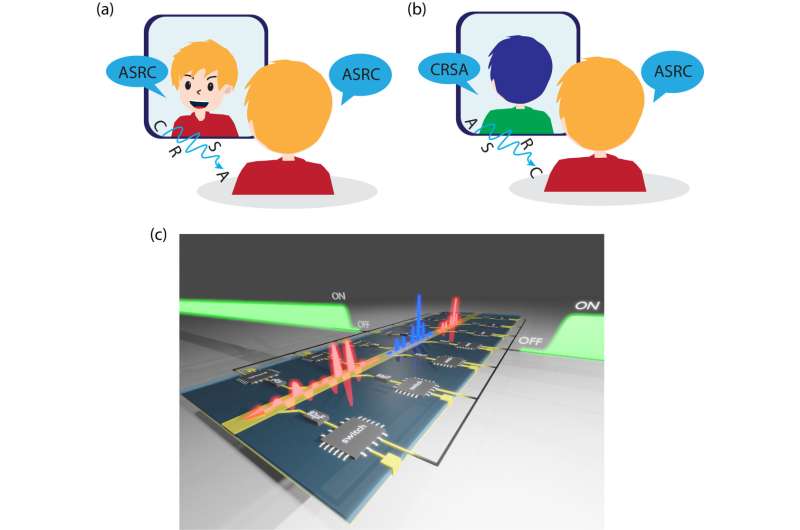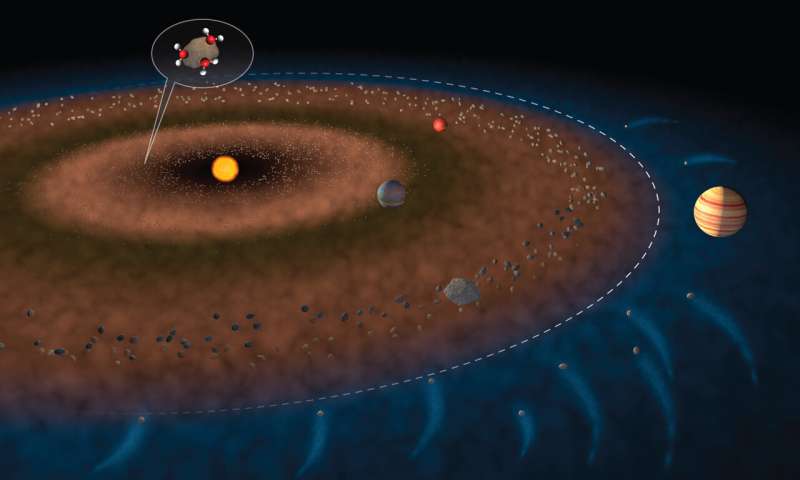
A neutron star made of collapsed atoms is the densest form of observable matter in the Universe, gravity on its surface is 200 billion times stronger than that of Earth
—–
Scientists Puzzled Because James Webb is Seeing Things that are Unexpected.
https://www.cseinsider.com/2022/08/scientists-puzzled-because-james-webb.html?fbclid=IwAR3VXuyvz1aZbKiizRFof1tPJMWq0BtYK183cSMUr92Ypn719nGLqn92AnE
Scientists demonstrate time reflection of electromagnetic waves

When we look in a mirror, we are used to seeing our faces looking back at us. The reflected images are produced by electromagnetic light waves bouncing off of the mirrored surface, creating the common phenomenon called spatial reflection. Similarly, spatial reflections of sound waves form echoes that carry our words back to us in the same order we spoke them.
Scientists have hypothesized for more than six decades the possibility of observing a different form of wave reflections, known as temporal, or time, reflections. In contrast to spatial reflections, which arise when light or sound waves hit a boundary such as a mirror or a wall at a specific location in space, time reflections arise when the entire medium in which the wave is traveling suddenly and abruptly changes its properties across all of space. At such an event, a portion of the wave is time reversed, and its frequency is converted to a new frequency.
To date, this phenomenon had never been observed for electromagnetic waves. The fundamental reason for this lack of evidence is that the optical properties of a material cannot be easily changed at a speed and magnitude that induces time reflections. Now, however, in a newly published paper in Nature Physics, researchers at the Advanced Science Research Center at the CUNY Graduate Center (CUNY ASRC) detail a breakthrough experiment in which they were able to observe time reflections of electromagnetic signals in a tailored metamaterial.
“This has been really exciting to see, because of how long ago this counterintuitive phenomenon was predicted, and how different time-reflected waves behave compared to space-reflected ones,” said the paper’s corresponding author Andrea Alù, Distinguished Professor of Physics at The City University of New York Graduate Center and founding director of the CUNY ASRC Photonics Initiative. “Using a sophisticated metamaterial design, we were able to realize the conditions to change the material’s properties in time both abruptly and with a large contrast.”
This feat caused a significant portion of the broadband signals traveling in the metamaterial to be instantaneously time reversed and frequency converted. The effect forms a strange echo in which the last part of the signal is reflected first. As a result, if you were to look into a time mirror, your reflection would be flipped, and you would see your back instead of your face. In the acoustic version of this observation, you would hear sound similar to what is emitted during the rewinding of a tape.
The researchers also demonstrated that the duration of the time-reflected signals was stretched in time due to broadband frequency conversion. As a result, if the light signals were visible to our eyes, all their colors would be abruptly transformed, such that red would become green, orange would turn to blue, and yellow would appear violet.
To achieve their breakthrough, the researchers used engineered metamaterials. They injected broadband signals into a meandered strip of metal that was about 6 meters long, printed on a board and loaded with a dense array of electronic switches connected to reservoir capacitors. All the switches were then triggered at the same time, suddenly and uniformly doubling the impedance along the line. This quick and large change in electromagnetic properties produced a temporal interface, and the measured signals faithfully carried a time-reversed copy of the incoming signals.
The experiment demonstrated that it is possible to realize a time interface, producing efficient time reversal and frequency transformation of broadband electromagnetic waves. Both these operations offer new degrees of freedom for extreme wave control. The achievement can pave the way for exciting applications in wireless communications and for the development of small, low-energy, wave-based computers.
“The key roadblock that prevented time reflections in previous studies was the belief that it would require large amounts of energy to create a temporal interface,” said Gengyu Xu, the paper’s co-first author and a postdoctoral researcher at CUNY ASRC. “It is very difficult to change the properties of a medium quick enough, uniformly, and with enough contrast to time reflect electromagnetic signals because they oscillate very fast. Our idea was to avoid changing the properties of the host material, and instead create a metamaterial in which additional elements can be abruptly added or subtracted through fast switches.”
“The exotic electromagnetic properties of metamaterials have so far been engineered by combining in smart ways many spatial interfaces,” added co-first author Shixiong Yin, a graduate student at CUNY ASRC and at The City College of New York. “Our experiment shows that it is possible to add time interfaces into the mix, extending the degrees of freedom to manipulate waves. We also have been able to create a time version of a resonant cavity, which can be used to realize a new form of filtering technology for electromagnetic signals.”
The introduced metamaterial platform can powerfully combine multiple time interfaces, enabling electromagnetic time crystals and time metamaterials. Combined with tailored spatial interfaces, the discovery offers the potential to open new directions for photonic technologies, and new ways to enhance and manipulate wave-matter interactions.
More information: Andrea Alù, Observation of temporal reflection and broadband frequency translation at photonic time interfaces, Nature Physics (2023). DOI: 10.1038/s41567-023-01975-y. www.nature.com/articles/s41567-023-01975-y
Journal information: Nature Physics
https://phys.org/news/2023-03-scientists-electromagnetic.html?fbclid=IwAR22b-I87HkM_8CZrrbSFU-MzozUCZGV-hiqCCM5n9fkrY8SzxZPOQ-uV4M
Where did Earth’s water come from? Not melted meteorites, according to scientists

Water makes up 71% of Earth’s surface, but no one knows how or when such massive quantities of water arrived on Earth.
A new study published in the journal Nature brings scientists one step closer to answering that question. Led by University of Maryland Assistant Professor of Geology Megan Newcombe, researchers analyzed melted meteorites that had been floating around in space since the solar system‘s formation 4 1/2 billion years ago. They found that these meteorites had extremely low water content—in fact, they were among the driest extraterrestrial materials ever measured.
These results, which let researchers rule them out as the primary source of Earth’s water, could have important implications for the search for water—and life—on other planets. It also helps researchers understand the unlikely conditions that aligned to make Earth a habitable planet.
“We wanted to understand how our planet managed to get water because it’s not completely obvious,” Newcombe said. “Getting water and having surface oceans on a planet that is small and relatively near the sun is a challenge.”
The team of researchers analyzed seven melted, or achondrite, meteorites that crashed into Earth billions of years after splintering from at least five planetesimals—objects that collided to form the planets in our solar system. In a process known as melting, many of these planetesimals were heated up by the decay of radioactive elements in the early solar system’s history, causing them to separate into layers with a crust, mantle and core.
Because these meteorites fell to Earth only recently, this experiment was the first time anyone had ever measured their volatiles. UMD geology graduate student Liam Peterson used an electron microprobe to measure their levels of magnesium, iron, calcium and silicon, then joined Newcombe at the Carnegie Institution for Science’s Earth and Planets Laboratory to measure their water contents with a secondary ion mass spectrometry instrument.
“The challenge of analyzing water in extremely dry materials is that any terrestrial water on the sample’s surface or inside the measuring instrument can easily be detected, tainting the results,” said study co-author Conel Alexander, a scientist at the Carnegie Institution for Science.
To reduce contamination, researchers first baked their samples in a low-temperature vacuum oven to remove any surface water. Before the samples could be analyzed in the secondary ion mass spectrometer, the samples had to be dried out once again.
“I had to leave the samples under a turbo pump—a really high-quality vacuum—for more than a month to draw down the terrestrial water enough,” Newcombe said.
Some of their meteorite samples came from the inner solar system, where Earth is located and where conditions are generally assumed to have been warm and dry. Other rarer samples came from the colder, icier outer reaches of our planetary system. While it was generally thought that water came to Earth from the outer solar system, it has yet to be determined what types of objects could have carried that water across the solar system.
“We knew that plenty of outer solar system objects were differentiated, but it was sort of implicitly assumed that because they were from the outer solar system, they must also contain a lot of water,” said Sune Nielsen, a study co-author and geologist at the Woods Hole Oceanographic Institution. “Our paper shows this is definitely not the case. As soon as meteorites melt, there is no remaining water.”
After analyzing the achondrite meteorite samples, researchers discovered that water comprised less than two millionths of their mass. For comparison, the wettest meteorites—a group called carbonaceous chondrites—contain up to about 20% of water by weight, or 100,000 times more than the meteorite samples studied by Newcombe and her co-authors.
This means that the heating and melting of planetesimals leads to near-total water loss, regardless of where these planetesimals originated in the solar system and how much water they started out with. Newcombe and her co-authors discovered that, contrary to popular belief, not all outer solar system objects are rich in water. This led them to conclude that water was likely delivered to Earth via unmelted, or chondritic, meteorites.
Newcombe said their findings have applications beyond geology. Scientists of many disciplines—and especially exoplanet researchers—are interested in the origin of Earth’s water because of its deep connections with life.
“Water is considered to be an ingredient for life to be able to flourish, so as we’re looking out into the universe and finding all of these exoplanets, we’re starting to work out which of those planetary systems could be potential hosts for life,” Newcombe said. “In order to be able to understand these other solar systems, we want to understand our own.”
The research paper, “Degassing of early-formed planetesimals restricted water delivery to Earth,” was published in Nature on March 15, 2023.
https://phys.org/news/2023-03-earth-meteorites-scientists.html?fbclid=IwAR1WRghVC9RNkEHHbc0zCEUQ_myiees1Pb6cwjafp4WUleavDYDG7oQaxOM

